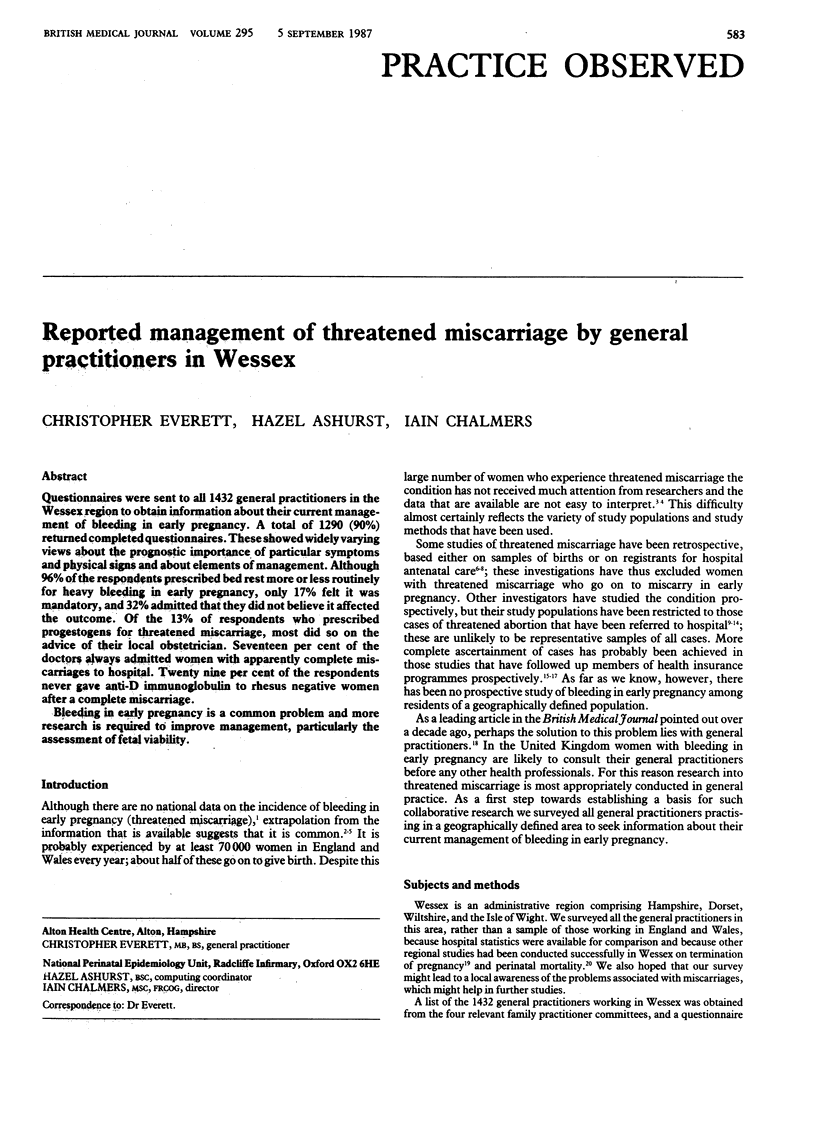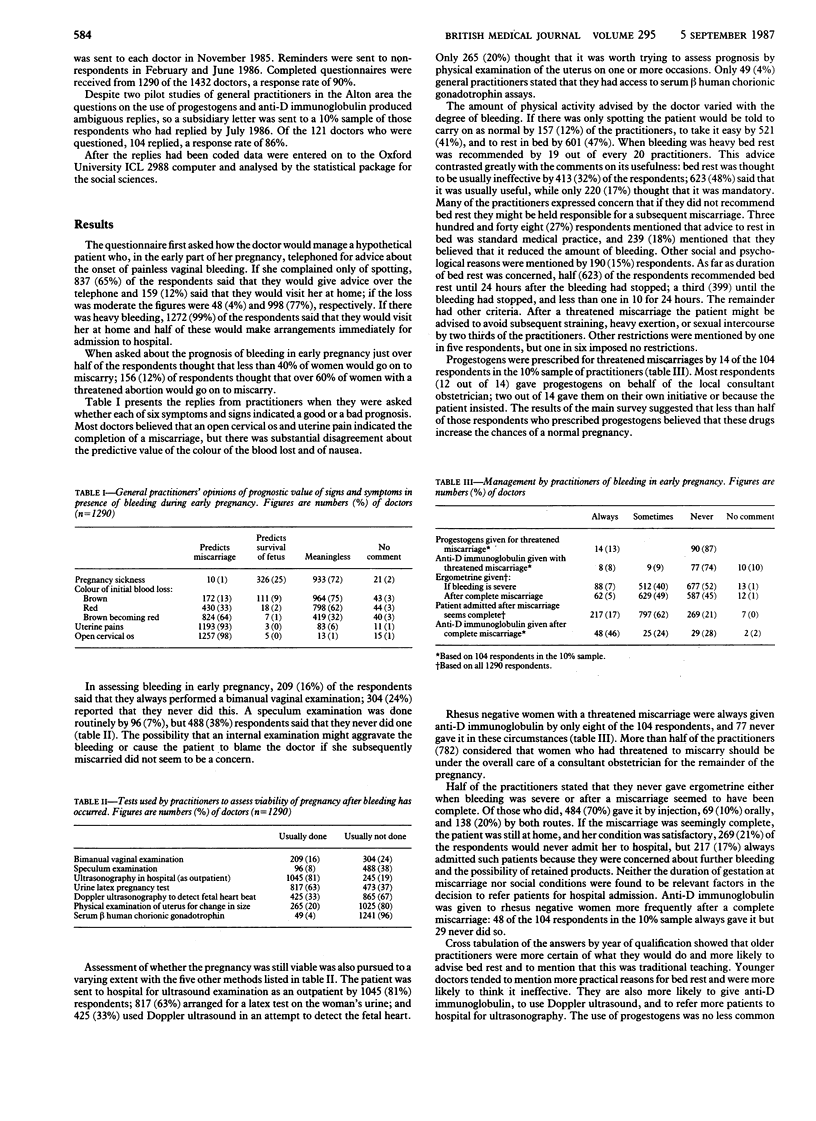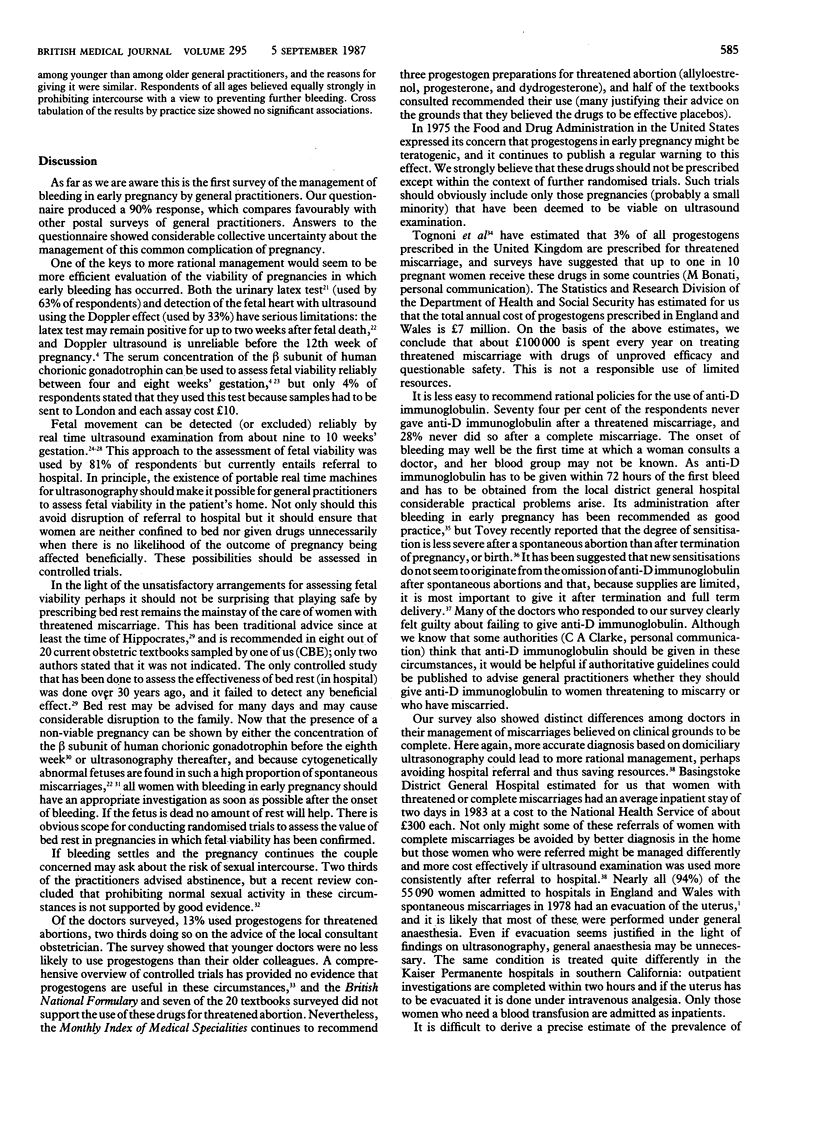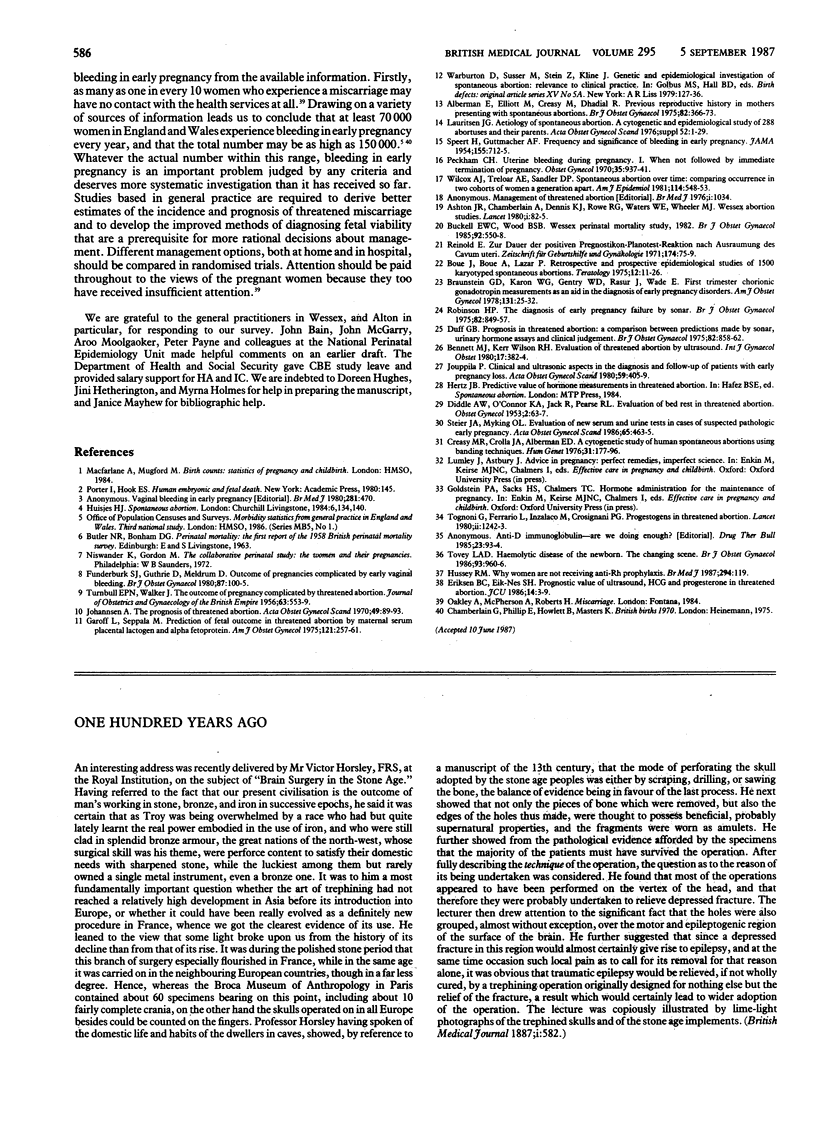Abstract
Questionnaires were sent to all 1432 general practitioners in the Wessex region to obtain information about their current management of bleeding in early pregnancy. A total of 1290 (90%) returned completed questionnaires. These showed widely varying views about the prognostic importance of particular symptoms and physical signs and about elements of management. Although 96% of the respondents prescribed bed rest more or less routinely for heavy bleeding in early pregnancy, only 17% felt it was mandatory, and 32% admitted that they did not believe it affected the outcome. Of the 13% of respondents who prescribed progestogens for threatened miscarriage, most did so on the advice of their local obstetrician. Seventeen per cent of the doctors always admitted women with apparently complete miscarriages to hospital. Twenty nine per cent of the respondents never gave anti-D immunoglobulin to rhesus negative women after a complete miscarriage. Bleeding in early pregnancy is a common problem and more research is required to improve management, particularly the assessment of fetal viability.
Full text
PDF



Selected References
These references are in PubMed. This may not be the complete list of references from this article.
- Alberman E., Elliott M., Creasy M., Dhadial R. Previous reproductive history in mothers presenting with spontaneous abortions. Br J Obstet Gynaecol. 1975 May;82(5):366–373. doi: 10.1111/j.1471-0528.1975.tb00651.x. [DOI] [PubMed] [Google Scholar]
- Ashton J. R., Dennis K. J., Rowe R. G., Waters W. E., Wheeller M. J. The Wessex abortion studies: I. Interdistrict variation in provision of abortion services. Lancet. 1980 Jan 12;1(8159):82–85. doi: 10.1016/s0140-6736(80)90504-8. [DOI] [PubMed] [Google Scholar]
- Boué J., Bou A, Lazar P. Retrospective and prospective epidemiological studies of 1500 karyotyped spontaneous human abortions. Teratology. 1975 Aug;12(1):11–26. doi: 10.1002/tera.1420120103. [DOI] [PubMed] [Google Scholar]
- Braunstein G. D., Karow W. G., Gentry W. C., Rasor J., Wade M. E. First-trimester chorionic gonadotropin measurements as an aid in the diagnosis of early pregnancy disorders. Am J Obstet Gynecol. 1978 May 1;131(1):25–32. doi: 10.1016/0002-9378(78)90469-6. [DOI] [PubMed] [Google Scholar]
- Buckell E. W., Wood B. S. Wessex perinatal mortality survey 1982. Br J Obstet Gynaecol. 1985 Jun;92(6):550–558. doi: 10.1111/j.1471-0528.1985.tb01391.x. [DOI] [PubMed] [Google Scholar]
- Creasy M. R., Crolla J. A., Alberman E. D. A cytogenetic study of human spontaneous abortions using banding techniques. Hum Genet. 1976 Feb 29;31(2):177–196. doi: 10.1007/BF00296145. [DOI] [PubMed] [Google Scholar]
- DIDDLE A. W., O'CONNOR K. A., JACK R., PEARSE R. L. Evaluation of bed rest in threatened abortion. Obstet Gynecol. 1953 Jul;2(1):63–67. [PubMed] [Google Scholar]
- Duff G. B. Prognosis in threatened abortion: a comparison between predictions made by sonar urinary hormone assays and clinical judgement. Br J Obstet Gynaecol. 1975 Nov;82(11):858–862. doi: 10.1111/j.1471-0528.1975.tb00589.x. [DOI] [PubMed] [Google Scholar]
- Eriksen B. C., Eik-Nes S. H. Prognostic value of ultrasound, HCG and progesterone in threatened abortion. J Clin Ultrasound. 1986 Jan;14(1):3–9. doi: 10.1002/jcu.1870140103. [DOI] [PubMed] [Google Scholar]
- Funderburk S. J., Guthrie D., Meldrum D. Outcome of pregnancies complicated by early vaginal bleeding. Br J Obstet Gynaecol. 1980 Feb;87(2):100–105. doi: 10.1111/j.1471-0528.1980.tb04500.x. [DOI] [PubMed] [Google Scholar]
- Garoff L., Seppälä M. Prediction of fetal outcome in threatened abortion by maternal serum placental lactogen and alpha fetoprotein. Am J Obstet Gynecol. 1975 Jan 15;121(2):257–261. doi: 10.1016/0002-9378(75)90650-x. [DOI] [PubMed] [Google Scholar]
- Hussey R. M. Why women are not receiving anti-Rh prophylaxis. Br Med J (Clin Res Ed) 1987 Jan 10;294(6564):119–119. doi: 10.1136/bmj.294.6564.119-a. [DOI] [PMC free article] [PubMed] [Google Scholar]
- Johannsen A. The prognosis of threatened abortion. Acta Obstet Gynecol Scand. 1970;49(1):89–93. doi: 10.3109/00016347009157520. [DOI] [PubMed] [Google Scholar]
- Jouppila P. Clinical and ultrasonic aspects in the diagnosis and follow-up of patients with early pregnancy failure. Acta Obstet Gynecol Scand. 1980;59(5):405–409. doi: 10.3109/00016348009155418. [DOI] [PubMed] [Google Scholar]
- Lauritsen J. G. Aetiology of spontaneous abortion. A cytogenetic and epidemiological study of 288 abortuses and their parents. Acta Obstet Gynecol Scand Suppl. 1976;52:1–29. [PubMed] [Google Scholar]
- Peckham C. H. Uterine bleeding during pregnancy. I. When not followed by immediate termination of pregnancy. Obstet Gynecol. 1970 Jun;35(6):937–941. [PubMed] [Google Scholar]
- Robinson H. P. The diagnosis of early pregnancy failure by sonar. Br J Obstet Gynaecol. 1975 Nov;82(11):849–857. doi: 10.1111/j.1471-0528.1975.tb00588.x. [DOI] [PubMed] [Google Scholar]
- SPEERT H., GUTTMACHER A. F. Frequency and significance of bleeding in early pregnancy. J Am Med Assoc. 1954 Jun 19;155(8):712–715. doi: 10.1001/jama.1954.03690260004002. [DOI] [PubMed] [Google Scholar]
- Steier J. A., Myking O. L. Evaluation of new serum and urine tests in cases of suspected pathologic early pregnancy. Acta Obstet Gynecol Scand. 1986;65(5):463–465. doi: 10.3109/00016348609157386. [DOI] [PubMed] [Google Scholar]
- TURNBULL E. P., WALKER J. The outcome of pregnancy complicated by threatened abortion. J Obstet Gynaecol Br Emp. 1956 Aug;63(4):553–559. doi: 10.1111/j.1471-0528.1956.tb05531.x. [DOI] [PubMed] [Google Scholar]
- Tognoni G., Ferrario L., Inzalaco M., Crosignani P. G. Progestagens in threatened abortion. Lancet. 1980 Dec 6;2(8206):1242–1243. doi: 10.1016/s0140-6736(80)92496-4. [DOI] [PubMed] [Google Scholar]
- Tovey L. A. Haemolytic disease of the newborn--the changing scene. Br J Obstet Gynaecol. 1986 Sep;93(9):960–966. doi: 10.1111/j.1471-0528.1986.tb08016.x. [DOI] [PubMed] [Google Scholar]
- Warburton D., Susser M., Stein Z., Kline J. Genetic and epidemiologic investigation of spontaneous abortion: relevance to clinical practice. Birth Defects Orig Artic Ser. 1979;15(5A):127–136. [PubMed] [Google Scholar]
- Wilcox A. J., Treloar A. E., Sandler D. P. Spontaneous abortion over time: comparing occurrence in two cohorts of women a generation apart. Am J Epidemiol. 1981 Oct;114(4):548–553. doi: 10.1093/oxfordjournals.aje.a113220. [DOI] [PubMed] [Google Scholar]


